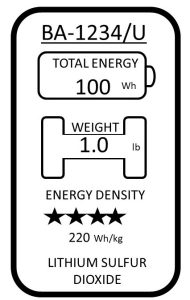For Army standard batteries, it is important to use only approved batteries because there has been extensive research and testing to ensure the final product performs to the specification (see Specifications) and meets safety requirements (see Safety Assessment Report). To assure you are getting an approved battery, only procure the NSN listed in your system’s Tech Manual or other official documentation. Do not buy commercially or directly from a battery vendor as these batteries lack proper oversight.
The Department of Defense has put a lot of time and manpower in the development of the chemistries that go into the batteries. Extensive testing of performance, safety of the battery, and electronics in the battery are performed at every stage of its development. Performance testing and safety testing are done on production lots before they get into the hands of Warfighters. Approved batteries are backed by the Government and Manufacturer for performance and safety. If there is an incident, the Government and the manufacturer will try to resolve and correct the issues with the batteries in production.
Did you know that standard Army batteries have a label to compare one option to another? It’s called the Simplified Battery Label. This label comes in two formats: rechargeable batteries are outlined by arrows to indicate repeated use, while non-rechargeable batteries are outlined by a solid border. Other than that, the labels are the same format.

Rechargeable

Non-Rechargeable
- The top line of the label is the military standard nomenclature for the battery.
- The battery icon contains the total energy available in the battery. This is how much work your battery can do before it is depleted. The more energy your battery has, the longer it can power your device.
- The barbell icon contains the weight of the battery.
- The energy density is represented with stars. Energy density is a ratio of how much energy is in the battery vs. how much mass it has. Each star represents 50 watt-hours per kilogram, but it’s not important to understand that in technical terms. Just remember that more stars a battery has, the better value it is in terms of how long it will run your equipment versus how much weight you need to lug around.
- The bottom line of the label lists the battery’s chemistry which can be useful in identifying any special storage, handling, or disposal requirements associated with it. Please reference relevant publications for more information.
